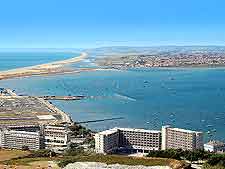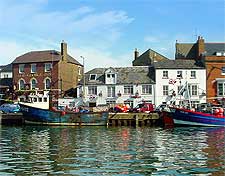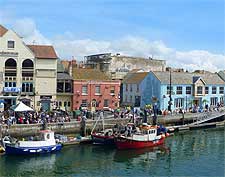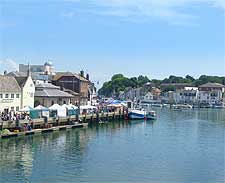Weymouth History Facts and Timeline
(Weymouth, Dorset, England)

Weymouth's history centres around its development as a port. Romans sailed up the River Wey to the Roman town of Durnovaria, or Dorchester as it's known today.
First mention of the port appears in 1100. At that time, Weymouth was actually made up of two separate towns - Weymouth on the south side of the river and harbour, and Melcombe Regis on the north side. Both were granted to the Convent and Prior of St. Swithin of Winchester.

Medieval Port to Royal Resort
As an active port, Weymouth was particularly affected by the Black Death. Indeed, the disease was thought to have been brought into Britain by a Gascon sailor who stepped ashore at Melcombe Regis in 1348. Many of the townsfolk fled to escape infection, thus spreading the disease further inland, with terrible consequences.
By the 16th century, there was such bitter rivalry between Weymouth and Melcombe Regis that Queen Elizabeth I granted a Royal Charter to unite the two communities into a single borough.
In 1789, King George III first visited Weymouth and enjoyed himself so much that he continued to spend his holidays here every year. His last visit was in 1805. To honour the King's influence on the town's success as a seaside resort, the town erected 'The Painted Statue' in 1810.

Weymouth in the 19th Century
During the 1800s, there were various schemes aimed at increasing the size of Weymouth's harbour. In 1872, a dam was built to maintain the level of the water in the Inner Harbour and Radipole Lake, allowing the port to prosper. In the mid-1880s, Cosens and Company set up a successful passenger steamer service to take passengers to towns along the south coast.
In 1857, the Great Western Railway began operating a regular steam packet service and engineer Isambard Kingdom Brunel was commissioned to design a railway station for the town. In 1865, a separate track was run from the mainline railway station, connecting it with the passenger ferries, as well as with cargo ships. The rail extension allowed goods arriving from the Channel Islands to be taken more easily from boats to warehouses.
During the year of 1887, one of Weymouth's most distinctive landmarks was erected. The Jubilee Clock commemorated the 50th anniversary of Queen Victoria's coronation.

Modern Weymouth
Weymouth was to play an important role during the history of the Second World War. As a result of the German occupation of the Channel Islands, Alderney's residents were evacuated into Weymouth in June 1940. Half a million soldiers set off from the port between D-Day on 6th June 1944 and 7th June 1945, mostly forming the group that landed on Omaha Beach.
Throughout the 20th century, Weymouth has remained an important harbour, both for fishing and recreational purposes. In 1921, the current tidal dam and Westham Bridge were built, thus allowing the inner harbour to be used at all tide depths. During the 1980s and 1990s, Weymouth hosted the Cutty Sark Tall Ships race on no fewer than three occasions - a world record, with the 2012 Olympic and Paralympic sailing competitions at Weymouth Bay being another highlight. Its many visitors also come to enjoy the town's beaches and its continued ferry links with the
Channel Islands and
France.
 Weymouth's history centres around its development as a port. Romans sailed up the River Wey to the Roman town of Durnovaria, or Dorchester as it's known today.
Weymouth's history centres around its development as a port. Romans sailed up the River Wey to the Roman town of Durnovaria, or Dorchester as it's known today.

